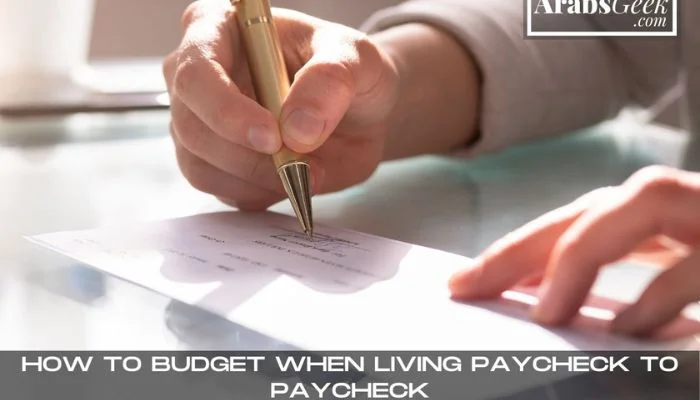Introduction | How To Budget When Living Paycheck To Paycheck
Living paycheck to paycheck can be an exhausting and stressful experience. With the rising cost of living and stagnant wages, many individuals find themselves struggling to make ends meet. However, creating a budget and adopting smart money management strategies can help break this cycle and achieve financial stability. This article will discuss the importance of budgeting, tips for stretching your paycheck, practical money-saving strategies, and how to change your money mindset when living paycheck to paycheck.
Table of Contents
Understanding Paycheck-to-Paycheck Living
What does it mean? | How To Budget When Living Paycheck To Paycheck
Living paycheck to paycheck means relying entirely on your income from one pay period to cover all your expenses until the next one. In this situation, you’re unable to save money or build an emergency fund, leaving you vulnerable to unexpected expenses and financial stress.
For any business enquiry, you can contact us at ArabsGeek.com
For more of such financial articles, Consider visiting our sister website at EntrepreneursPilot.com
The cycle of living paycheck to paycheck
The paycheck-to-paycheck cycle can be difficult to break, especially when faced with unexpected expenses, such as medical bills or car repairs. This often leads to accumulating debt and feeling trapped in a never-ending cycle of financial instability.
The Importance of Budgeting | How To Budget When Living Paycheck To Paycheck
Breaking the cycle
Creating a budget is a crucial step in breaking the paycheck-to-paycheck cycle. It allows you to take control of your finances by tracking your income and expenses, identifying areas where you can cut back, and setting realistic financial goals.
Financial control and stability
Budgeting provides you with a clear picture of your financial situation, helping you make informed decisions and develop healthy money habits. In turn, this can lead to financial stability and the ability to handle unexpected expenses without falling back into the paycheck-to-paycheck cycle.
Creating a Budget | How To Budget When Living Paycheck To Paycheck
Assess your income and expenses
To create a budget, start by assessing your income and expenses. List all sources of income, including your salary, side gigs, and any other earnings. Next, list all your expenses, including fixed expenses (such as rent, mortgage, or utilities) and variable expenses (like groceries, entertainment, and transportation). This will give you a clear picture of your financial situation and help you identify areas where adjustments can be made.
Categorize your expenses
Organize your expenses into categories, such as housing, transportation, food, healthcare, and entertainment. This will make it easier to see where your money is going and identify areas where you can cut back or make adjustments.
Set realistic goals | How To Budget When Living Paycheck To Paycheck
Once you have a clear understanding of your income and expenses, set realistic financial goals. These can include paying off debt, building an emergency fund, or saving for a specific purpose. Make sure your goals are specific, measurable, achievable, relevant, and time-bound (SMART).
Monitor and adjust your budget
Your budget should be a living document that you regularly review and adjust as needed. Track your spending and compare it to your budget, making adjustments as necessary. This will help ensure that you stay on track and continue making progress toward your financial goals.
Tips to Stretch Your Paycheck | How To Budget When Living Paycheck To Paycheck
Cut unnecessary expenses
Identify areas where you can cut back on spending, such as dining out, entertainment, or subscription services. Look for ways to reduce your expenses without sacrificing your quality of life, such as cooking at home more often or finding free or low-cost alternatives to your favorite activities.
Prioritize debt repayment
Paying off high-interest debt should be a priority, as it can free up more money for other financial goals. Create a debt repayment plan that focuses on paying off the highest-interest debt first while still making minimum payments on other debts. This will help you save money on interest and pay off your debts faster.
Find additional sources of income | How To Budget When Living Paycheck To Paycheck
If your current income isn’t enough to cover your expenses and meet your financial goals, consider finding additional sources of income. This could include taking on a part-time job, freelancing, or starting a side gig. Extra income can help you break the paycheck-to-paycheck cycle and achieve financial stability.
Build an emergency fund
An emergency fund is crucial for breaking the paycheck-to-paycheck cycle. Start by setting aside a small amount from each paycheck until you have enough to cover at least three months’ worth of living expenses. This will provide a financial cushion in case of unexpected expenses or a loss of income.
Practical Money-Saving Strategies
Meal planning and grocery shopping
Meal planning and smart grocery shopping can help you save money on food expenses. Plan your meals for the week, create a shopping list, and stick to it. This will help you avoid impulse purchases and reduce food waste.
Save on utilities | How To Budget When Living Paycheck To Paycheck
Reducing your utility costs can help stretch your paycheck further. Turn off lights when not in use, unplug electronics, and use energy-efficient appliances. Additionally, consider using a programmable thermostat to manage heating and cooling costs.
Take advantage of discounts and deals
Look for sales, discounts, and deals on items you regularly purchase. Use coupons, sign up for store loyalty programs, and take advantage of cashback apps to save money on everyday expenses.
DIY and frugal living | How To Budget When Living Paycheck To Paycheck
Embrace a frugal lifestyle by finding ways to do things yourself, such as home repairs or cooking from scratch. This can help you save money while also learning valuable skills.
Changing Your Money Mindset
Recognize and challenge negative beliefs
Identify any negative beliefs you may have about money and challenge them. Recognizing and addressing these beliefs can help you develop a healthier relationship with money and improve your financial situation.
Focus on long-term financial goals
Instead of focusing solely on immediate financial needs, consider your long-term financial goals and work towards them. Having a clear vision of your financial future can help motivate you to make better decisions and stay committed to your budget.
Celebrate small victories | How To Budget When Living Paycheck To Paycheck
As you make progress toward your financial goals, take the time to celebrate your accomplishments, no matter how small they may seem. This will help keep you motivated and reinforce your commitment to breaking the paycheck-to-paycheck cycle.
Conclusion | How To Budget When Living Paycheck To Paycheck
Breaking free from living paycheck to paycheck is possible with careful planning, discipline, and a commitment to making positive financial changes. By creating a budget, identifying areas for improvement, and adopting practical money-saving strategies, you can regain control of your finances and work towards a more stable financial future. Remember to focus on your long-term goals, celebrate your successes, and stay dedicated to your budget to achieve lasting financial stability.
Frequently Asked Questions (FAQs)
Q1: What is the first step to stop living paycheck to paycheck?
The first step is to create a budget that outlines your income and expenses. This will help you understand your financial situation, identify areas where you can cut back, and set realistic financial goals.
Q2: How can I save money when living paycheck to paycheck?
Focus on reducing unnecessary expenses, prioritizing debt repayment, finding additional sources of income, and building an emergency fund. Additionally, adopt practical money-saving strategies, such as meal planning, energy conservation, and taking advantage of discounts and deals.
Q3: How much should I aim to have in an emergency fund?
Aim to have at least three months’ worth of living expenses in your emergency fund. This will provide a financial cushion in case of unexpected expenses or a loss of income.
Q4: How can I change my money mindset to break the paycheck-to-paycheck cycle?
Recognize and challenge any negative beliefs about money, focus on your long-term financial goals, and celebrate your small victories along the way. A positive money mindset can help you stay committed to your budget and achieve financial stability.
Q5: What are some additional sources of income I can consider to break the paycheck-to-paycheck cycle?
Consider taking on a part-time job, freelancing, or starting a side gig. Extra income can help you break the paycheck-to-paycheck cycle and achieve financial stabi











